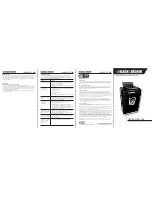
16 / 84
PL
SK
EN
CS
HU
• Dangers caused by shooting up of subjects.
• Mechanical hazard, caused by cut and throw off.
• Noise risk resulting in loss of hearing (deafness) and other physiological disorders (e.g. loss
of balance, loss of consciousness).
• Vibration risk (resulting in vascular and neurological harm in the hand-arm system, for
example so called “white finger disease”).
WARNING!
B
The product produces an electromagnetic field of a very weak intensity. This field may
interfere with some pacemakers. To reduce the risk of serious or fatal injury, persons
with pacemakers should consult the use with their physician and the manufacturer.
ELECTRICAL REQUIREMENTS
• Never use at the nominal voltage other than 230V/50Hz. The circuit must be properly and
accordingly current protected.
RECOMMENDATIONS FOR PROTECTION CLASS II MACHINES
• Machines should be powered via a current protector (RCD) having a tripping current of not
more than 30 mA.
EXTENSION LEAD
• Always use a double-insulated power supply and the parameters corresponding to
the machine’s power consumption. The minimum cross section of the cable must be determined
according to the current or power data on the fork/label of the machine. It‘s not only necessary
to take the load into account, but also the length of the extension lead and the type of fuse.
• Position power supply cable so it does not interfere with the work and is not damaged.
• Only use rubberised extension cables with sufficient conductor cross section and fully
developed.
Minimum cross-sections of the e fully developed extension cord:
- up to 6 A including: > 0.75 mm
2
;
- up to 10 A including: > 1.0 mm
2
;
- up to16 A including: > 1.5 mm
2
;
Maximum cable length in relation to the cross section
Cable cross section (mm
2
)
0,75
1
1,5
2,5
Maximum possible length (m)
30
40
60
100
• The correct maximum load of the extension cable must always be indicated on its label.
• Use only outdoor cables, preferably colour-coded, well visible. This reduces the chance of
accidental damage to the cable.
UNPACKING
• Carefully remove the product from the box.
• Carefully inspect all parts.












































